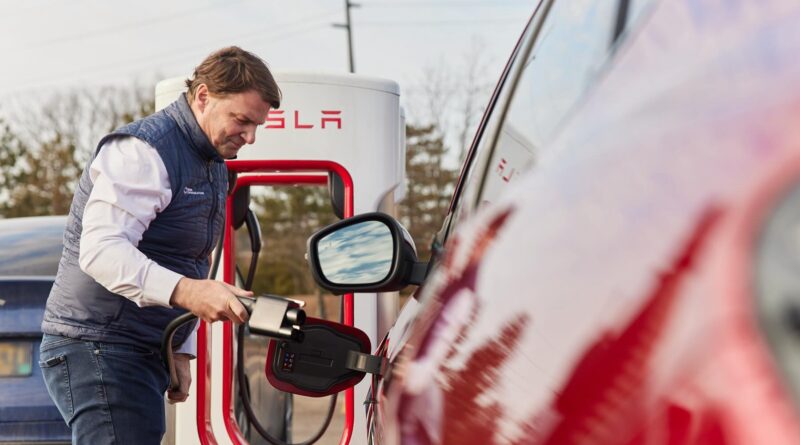
Not only that, the Tesla Superchargers work as intended — something that can’t be said for the chargers at other EV charging companies. Arrive, plug in, and charging begins in seconds. The cost of each charging session is automatically billed to the credit card associated with the customer’s Tesla account — no cards to tap or apps to download. The Supercharger network is recognized as the gold standard that all other charging companies aspire to match if they can. So far, none have.
In North America, Tesla uses a proprietary plug that is a thing of efficiency and beauty compared to the clunky CCS equipment everyone else uses. The Tesla device, known as NACS, which stands for North American Charging Standard, is so superior to the CCS option that virtually all other EV manufacturers agreed to adopt for their cars sold in North America. SAE quickly created a new standard known as J3400. By 2025, virtually all electric cars sold in North America will come from the factory with charging ports that use the J34o0 standard.
The Biden administration had made billions of dollars available to bring more EV chargers to America, not just along interstate highways and other major transportation routes, but in cities and rural areas where chargers today are scarcer than chicken lips. But now Elon has had one of his typical brain farts. Like an infant throwing toys out of the crib, he has summarily fired the head of the Supercharger division along with about 500 people who were part of the Supercharger team.
In truth, no one quite knows yet what the result of this new course change by Tesla will be. We aren’t sure if even Elon knows. But other companies are sniffing around, wondering if there is an opportunity here. It is unlikely those former Tesla Supercharger team members will be unemployed for long. One of those companies is BP, once known as British Petroleum. It has created a new division called BP Prime that purports to be seeking ways for the company — one of the biggest polluters in history — to transition to a low-carbon business model.
BP now says it is eager to snap up Tesla Supercharger sites across the US — along with the employees who made them possible. It has pledged $1 billion by 2030 to expand its network. The company said it “is aggressively looking to acquire real estate to scale our network, which is a heightened focus following the recent Tesla announcement.” It plans to spend half of that $1 billion within the next two to three years to install more than 3,000 charging points across the US. A key part of the strategy is building large scale hubs with 12 or more chargers it will call Gigahubs, an obvious allusion to Elon’s penchant for applying the term “giga” to everything he touches.
“If there are stranded real estate partners who are looking for someone to call, they should feel free to pick up the phone and call me or look me up on LinkedIn,” Sujay Sharma, chief executive officer of BP Pulse Americas, said in an interview with Bloomberg. “We are actively seeking good talent and real estate opportunities that allow us to help grow, despite whatever else is going on around us,” Sharma said. The company last year signed a deal to procure about $100 million worth of Tesla Supercharger hardware, with the deployment expected to start later this year and early 2025, he said. That may be so, but Reuters reports that BP trimmed 10 percent of its the employees in its electric vehicle charging business recently and pulled out of several markets after a bet on rapid growth in commercial EV fleets didn’t pay off.
Other companies, including EVgo, see Tesla’s slowdown as a positive development that will help increase their market share, according to CEO Badar Khan. He foresees “a fairly significant change in the competitive dynamic in the charging space” that allows competitors like EVgo to pick up “the slack” in growth left behind by Tesla, he said on the company’s earnings call last week. The firm also is eager to take on Tesla employees and is in talks with site hosts left in the lurch. Tesla summarily cancelled many proposed new Supercharger locations, saying it would add more chargers to existing locations instead.
The DC fast chargers that BP Pulse plans to use will be compatible with both the North American Charging Standard (NACS) and Combined Charging System (CCS) standard and will provide 250 kW of power. That’s mid range power today, with many chargers capable of supplying 350 kW or more to cars that are able to accept that level of power.
Every dark cloud has a silver lining. Whatever Musk and Tesla are up to, others — like BP — are seeing opportunities that didn’t exist a few weeks ago. How this will play out won’t be known for some time, but no one is going to leave billions of federal dollars on the table untouched, except for certain red states which are actively opposed to all this woke nonsense about electric cars. They see the transition to zero emission transportation as a vast left-wing plot to deny Americans the right to experience the soul-stirring sound of a V-8 engine. Who cares about the environment? Let Mother Nature take care of herself!
It is interesting that BP, which brought us the horrific Deepwater Horizon disaster in the Gulf of Mexico, now wants to present a new, more climate friendly face to the world. Perhaps it should be applauded for doing so, but the deeply cynical policies of the fossil fuel companies makes it hard to believe they are suddenly interested in spreading low emissions pixie dust around. Perhaps as the shock waves from Tesla’s sudden decision to dismantle its Supercharger team settle down, we will get a clearer picture of what the future or high-speed charging in North America will look like.